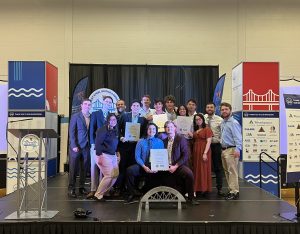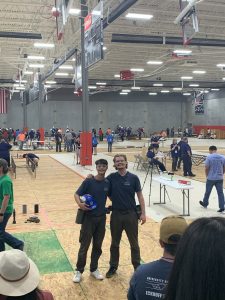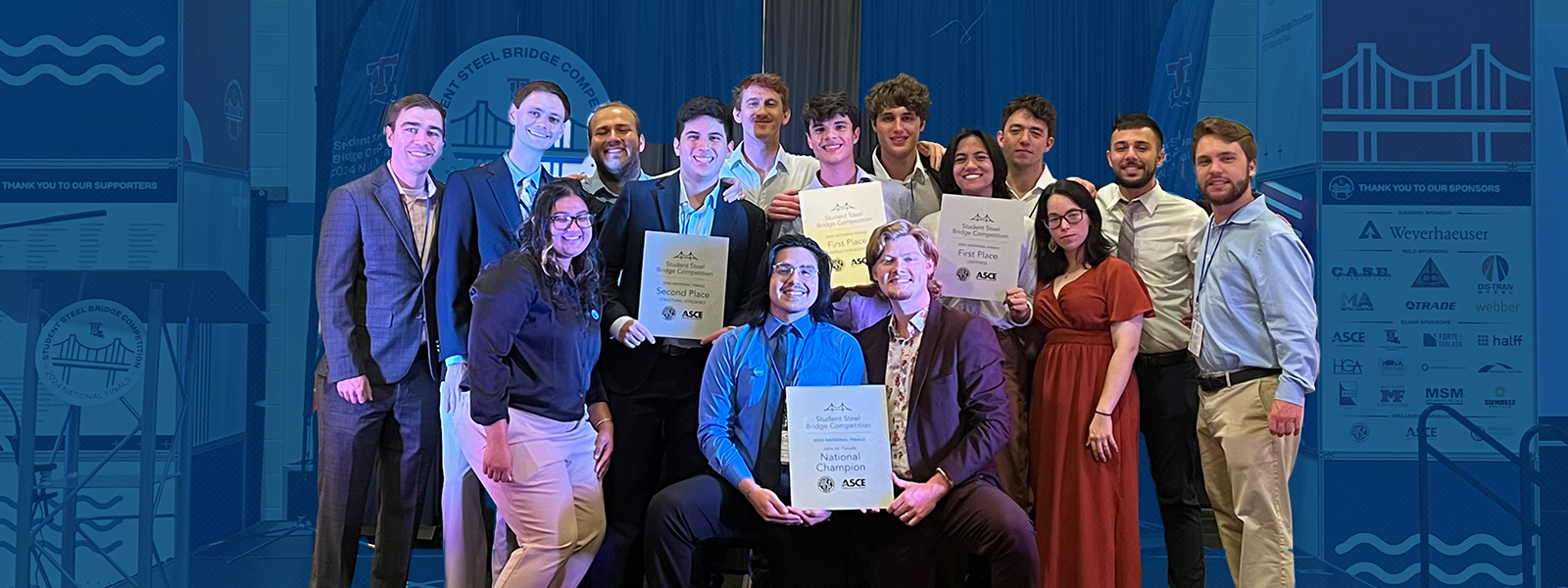The University of Florida’s Eckhoff Steel Bridge team has made history. For the fourth year in a row, the team has won at the American Institute of Steel Construction’s 2024 Student Steel Bridge Competition National Finals.
No other team has won national championships for three consecutive years, let alone four. The UF team claimed its latest championship earlier this month at Louisiana Tech University, squaring off against 46 other teams, which were narrowed down at regional competitions from nearly 200 teams.

“The bridge assembly team has set the standard for the competition with first-place economy scores—bridge construction speed with the number of builders—in each of the last four years,” said Team Faculty Advisor Taylor Rawlinson, Ph.D.
He has been with the team since 2016, became faculty advisor in 2019, and said this is hopefully just the beginning of a historical run. He credits the team’s growth and culture for their success. Members, he said, dedicate significant time to design, fabrication, and professional development by running workshops and encouraging students to get involved with an emphasis on team continuity every year.
The design team has achieved unparalleled success, claims six national titles: 1997, 2015, 2021, 2022, 2023, 2024. The team also achieved four second place finishes in 1995, 2005, 2008 and 2019 and two third place finishes in 2003 and 2016.
Led by student project managers Donald Stowell-Moore and Anthony Perez Ortegon, the team placed first overall. In addition to placing first in the economy, they also earned first place in lightness, with the bridge weighing 206 pounds, and fourth place in stiffness. These two category scores resulted in a second-place efficiency placement that considers the effectiveness of the bridge in carrying 2,500 pounds of added weight.
“Planning the assembly portion of the competition started back in fall with the design of the bridge,” Stowell-Moore said. “During design, we focused on balancing stiffness with assembly speed. We adjusted the stiffness to make the assembly quicker and easier by strategically using fewer pieces. We also aimed to keep our design ‘flexible’ enough to give us many options for assembly, allowing us to adapt to a two-person build.”
The team wanted to tighten up a few things after they competed—and won—in regionals. Stowell-Moore mentioned that two of the key focus areas were cutting down the assembly time and fabrication process.
[Best_Wordpress_Gallery id=”27″ gal_title=”2024 Student Steel Bridge Competition National Finals”]
Damian Blanco, a civil engineering junior and the team’s fabrication manager and upcoming project manager, worked with Stowell-Moore on the two-person build that presented unique challenges with the fabrication techniques and assembly time.
“Unseen challenges come up every year with fabrication,” said Blanco. “This year, we focused on cleaning up our techniques, and reducing the small errors that often pile up into one large one. The best way I found to overcome these errors was through discussions with the team, brainstorming and executing solutions together.”
Stowell-Moore and Blanco credit the team for its consistency in practice.

“Damian and I spent six to eight hours each day practicing, including a rest day or two, during the week leading up to the national competition, including the time we spent practicing for the regional competition,” Stowell-Moore said.
“Practicing that much was only possible due in part to the work of the rest of the team, as they would disassemble the bridge and reset the pieces in the staging yard for another run while Damian and I rested. This allowed us to keep our energy high, even with a two-man build.”
Blanco knows he has big shoes to fill as he plans to share the future role as project manager with fellow student Emma Robert next year. He enjoyed the team’s introduction to workshops and innovative ideas from members and plans to incorporate that into next year’s preparation.
“Everyone on the team truly has a substantial impact on some part of the bridge, and I hope to preserve this practice going into the future by involving new members in discussions, listening, and using their ideas while problem solving,” he said. “I feel that seeing your ideas being brought to life is such a strong motivator and we hope to use this to encourage new members to participate and feel welcomed to the team.”
“The most challenging part of the competition has to be the decision making,” Perez Ortegon said. “As engineers, part of our job is to be the one responsible for making the right decisions using our engineering judgement. However, most schooling and classes are set up such that there is only one acceptable answer. In contrast, practical engineering has many solutions you can choose from. Learning to choose one, how to justify and defend your position, and then follow through is the greatest benefit and challenge of participating in this competition. It teaches you to respect other people’s ideas, to keep an open mind, and that it’s OK to concede your position because we want to find the most efficient solution.”
In the competition, students must balance material costs, design efficiency, and construction speed to create the most cost-efficient bridge, Perez Ortegon described. This year, the bridges were at least 20 feet in length. The goal is to create a lightweight bridge that bends minimally and assembles quickly while meeting specific load and size requirements. The construction site includes obstacles like rivers and transportation zones, adding to the challenge. Failing to meet the design and construction requirements incurs penalties.
Each member of the steel bridge team played an intricate role in its success. The design team members are Perez Ortegon (project manager), Stowell-Moore (project manager/assembly team), Blanco (fabrication manager/assembly team), Robert (fabrication manager), Artem Egorov (design lead), Josh Lucero (design lead), Victor Levin (design intern), Maxwell Fletcher (administrative lead), Scherezada Lozada (finance lead/safety steward), John Willetts (technician), Saharah Alamgir (technician), Thomas Mackle (technician), Joseph “Brock” Sullivan (graduate advisor), Fletcher D’Arcy (graduate advisor) and Rawlinson. (faculty advisor).
“I came to UF to be part of this team. Ever since I joined, it’s been a place that enabled me to devote myself to whatever I am passionate about,” Perez Ortegon said. “Whether it was learning how to use tools, developing the team’s infrastructure, or designing and planning the fabrication of this year’s bridge—I’ve always been welcomed. All I can hope is that this team continues to be a place that allows students to learn and encourages people to follow their passions for structural engineering, project engineering and personal development. Not to mention, this is a team where you make great friends!”
As the team celebrates its fourth consecutive title and looks ahead to next year’s ideas, Stowell-Moore contends Rawlinson does not get enough credit for the team’s success.
“We’re lucky to have Dr. Rawlinson who motivates us to work hard, and a team culture that is dedicated to keeping the steel bridge team the best team in the nation. We are a tight-knit group of engineering students that share a passion for innovation, and the comradery of this team is one of the key attractors for new students,” Stowell-Moore said.
—
Written by Reba Liddy
ESSIE Marketing and Communications Specialist

